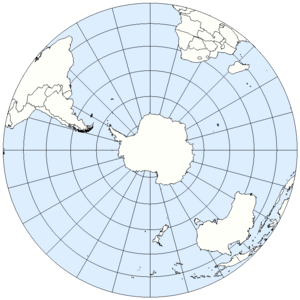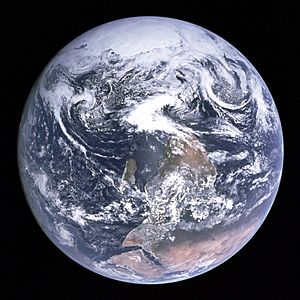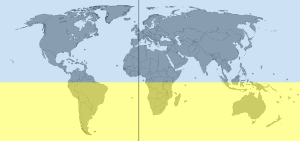Southern Hemisphere facts for kids

The Southern Hemisphere is the half of Earth that is south of the Equator. It includes all or parts of five continents: Antarctica, Australia, most of South America, part of Africa, and some islands near Asia. It also has four oceans: the Indian, South Atlantic, Southern, and South Pacific oceans. Most of the Pacific Islands in Oceania are also here.
This part of the world is mostly water, about 80.9% of its surface. The other half of Earth, the Northern Hemisphere, has less water, about 60.7%. Because Earth is tilted as it spins around the Sun, summer in the Southern Hemisphere is from December to March. Winter is from June to September. The South Pole is right in the middle of this southern half of Earth.
Contents
What Makes the Southern Hemisphere Special?
The weather in the Southern Hemisphere is often a bit milder than in the Northern Hemisphere. This is true for places at similar distances from the Equator. The only exception is Antarctica, which is colder than the Arctic. This happens because the Southern Hemisphere has much more ocean and less land. Water heats up and cools down slower than land.
If you are in the Southern Hemisphere, the sun appears to move from east to west through the north sky. This is different from the Northern Hemisphere, where the sun moves through the southern sky. Shadows cast by the sun move in an anti-clockwise direction during the day. Also, sundials in the Southern Hemisphere show hours increasing anti-clockwise.
When you watch a solar eclipse from the Southern Hemisphere, the Moon moves from left to right across the Sun. In the Northern Hemisphere, it moves from right to left.
Big storms like cyclones and tropical storms spin clockwise in the Southern Hemisphere. This is because of something called the Coriolis effect. In the Northern Hemisphere, these storms spin anti-clockwise.
The southern temperate zone is a part of the Southern Hemisphere that is almost all ocean. This zone includes the southern parts of Uruguay, South Africa, Chile, and Argentina. It also covers parts of Australia (south of Adelaide) and all of New Zealand.
The night sky looks amazing from the Southern Hemisphere. The Sagittarius constellation, which includes the center of the Milky Way galaxy, is a southern constellation. So are the two Magellanic Clouds. This means you can see brighter and more stars from here.
Forests in the Southern Hemisphere are unique. For example, Chile and Australia have special kinds of beech trees called Nothofagus. New Zealand has similar trees. The eucalyptus tree is originally from Australia. But now it is also grown in Southern Africa and Latin America for making paper and biofuel.
People and Places

About 800 million people live in the Southern Hemisphere. This is only about 10-12% of the world's total population. Of these 800 million people, 200 million live in Brazil. Brazil is the largest country in the Southern Hemisphere by land area. Another 141 million people live on the island of Java, which is the most crowded island in the world.
The country with the most people in the Southern Hemisphere is Indonesia. It has 261 million people. Most of them live south of the Equator. The most spoken language here is Portuguese. After that comes Spanish and Javanese.
The biggest cities in the Southern Hemisphere are São Paulo (Brazil), Jakarta (Indonesia), Buenos Aires (Argentina), Rio de Janeiro (Brazil), Kinshasa (Democratic Republic of the Congo), Lima (Peru), Johannesburg (South Africa), Santiago (Chile), and Sydney (Australia). These cities are also important for business and money.
Australia and New Zealand are among the most developed countries in the Southern Hemisphere. They have high incomes and good living standards. Some of the least developed countries are in Africa and Oceania, like Burundi and Mozambique.
The main religions in the Southern Hemisphere are Christianity in South America, southern Africa, Australia, and New Zealand. Islam is common in Indonesia and parts of southeastern Africa. Hinduism is mostly found on the island of Bali and nearby islands.
The oldest city that has been lived in continuously in the Southern Hemisphere is Bogor in western Java, Indonesia. It was founded in 669 CE. Some evidence suggests that Zanzibar in Tanzania might be even older. Ancient texts mention it as a trading port. The oldest major civilizations in the Southern Hemisphere were the Norte Chico civilization and Casma–Sechin culture in Peru. They built cities and pyramids as far back as 3600 BCE.
Continents and Countries in the Southern Hemisphere
Continents and Large Landmasses
- Africa: About one-third of Africa is in the Southern Hemisphere.
- Antarctica: This entire continent and its islands are completely in the Southern Hemisphere.
- Asia: Only the very southern islands, like East Timor and most of Indonesia, are in this hemisphere.
- Australia: The whole continent, including New Guinea and Tasmania, is in the Southern Hemisphere.
- South America: Most of South America is in the Southern Hemisphere.
- Zealandia: This includes New Caledonia, New Zealand, Norfolk Island, and other islands. They are all in the Southern Hemisphere.
Countries and Territories
See also
 In Spanish: Hemisferio sur para niños
In Spanish: Hemisferio sur para niños




